Schedule Windows XP to defragment the disk
 Defragmenting HDD is probably familiar to people who often use computers. To make this work more frequent and periodic, Windows XP provides you with a utility that makes it easy to 'schedule' defragmentation.
Defragmenting HDD is probably familiar to people who often use computers. To make this work more frequent and periodic, Windows XP provides you with a utility that makes it easy to 'schedule' defragmentation.
After a long time of using the computer, your hard drive will appear fragmented drive. Simply understanding that the accessed files will be stored in different locations of the sectors on the hard drive, creating free space on your hard drive, making access to the files The hard drive will be slowed down. Therefore, performing defragmentation (Defragment) will help reduce the amount of free space on the hard drive, reduce the sluggishness and increase the speed of the hard drive.
Windows operating systems also provide users with their own utility to perform disk defragmentation. However, how do you know when to do defragmentation work? And how to remember to always do this on a regular basis, so that the drive is not fragmented too much? For simplicity, we can set up Windows to conduct this task periodically on a monthly, weekly or even daily basis. To do this, follow these steps:
- First, click on Start , select Control Panel to open the Control Panel window.
- Control Panel window appears. Here, if Control Panel is in Classic View display mode, click on Scheduled Tasks . Otherwise, if your Control Panel is being displayed under Category View mode, click on Performance and Maintenance and click on Scheduled Tasks . After that, you continue to select Add Scheduled Task .
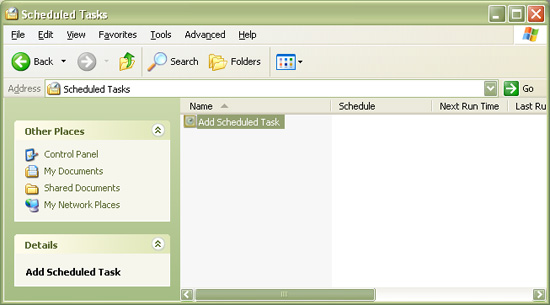
- After selecting Add Scheduled Task , the Scheduled Task Winzard window will be displayed, allowing you to start the automatic defragmentation process. You click on Next to begin the process.
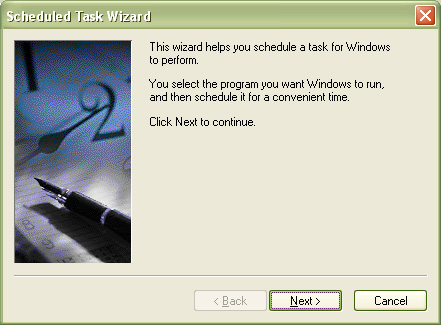
- At the next step, click on Browse and then continue to choose the path: C: Windowssystem32 . Here, select the file called dfrg or the defrag.exe file and click Open .
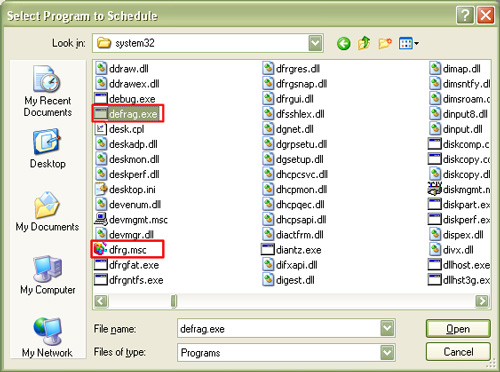
- In the next window, the process will allow you to name the newly created task, and set a period of time to perform this task (the specific task here is to defragment the task). plate). You can set Windows to automatically perform disk defragmentation on a daily basis ( Daily ), weekly ( Weekly ), monthly ( Monthly ), or at a single time ( One time Only ), when the system start ( When my computer Starts ) or when you log in to the system ( When I log on ). Typically, disk fragmentation only takes place after a long time of using the computer, so you should set Windows to automatically defragment the disk every month ( Monthly ) to ensure the process of defragmenting. Disk fragments work effectively. After naming the task and setting the time to execute the task, click Next to proceed to the next step.
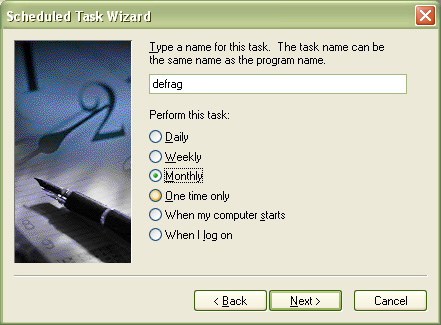
- In the next step, the process will allow you to set a specific time to perform disk defragmentation. For example, you must set specific days, hours and minutes in a month so that the program can execute correctly at the time you set. After setting up the appropriate amount of time, click Next to be able to go to the next step.
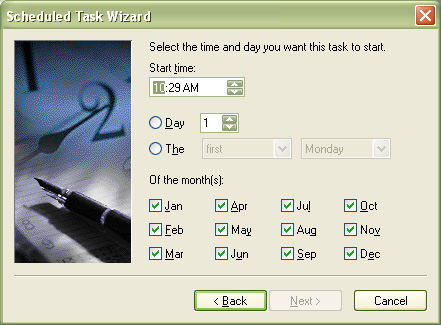
- At the last step, the process will ask you to enter the account login information used to be able to perform defragmentation. In case you only use one account on your computer, you can skip this step and click Next , and finally click Finish to finish the setup process.
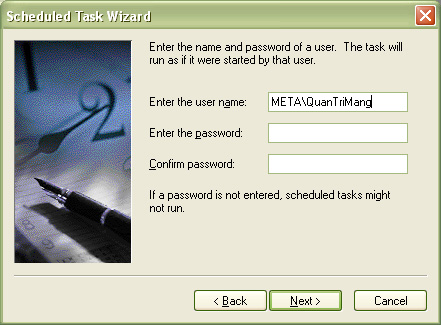
- After the setup process finishes, go back to the previously opened Scheduled Tasks window, and you will see a new task that you have just created in the list (this task will bring your own name during the setup process). Now, right click on the new task you just created, select Properties. A new window will open, where you check the Run Only if Logged on option to make sure that the automatic defragmentation process can only be performed after the system has been started. Click OK to close this window.
So you've completed the steps to set up Windows that can automatically perform a periodic defragmentation process at a predetermined time. This will help your hard drive to be defragmented on a regular basis, making the hard drive not fall into too fragmented status, affecting the access speed of the hard drive.
You should read it
- How to cancel scheduled Chkdsk activity in Windows 10
- How to timer display YouTube notifications on iPhone and Android
- How to Defrag Windows 7
- The TRIM hard drive error on Windows Defrag has not been fixed
- How to schedule a meeting on Microsoft Teams
- How to use Smart Defrag to defragment hard drives effectively
 6 steps to improve Windows XP speed
6 steps to improve Windows XP speed Connect your Windows XP computer from Windows Vista
Connect your Windows XP computer from Windows Vista 'Clear the way' for Win XP to boot faster (Part 1)
'Clear the way' for Win XP to boot faster (Part 1) 'Clear the road' for faster Windows XP booting (Part 2)
'Clear the road' for faster Windows XP booting (Part 2) Set the auto-login mode to Windows XP
Set the auto-login mode to Windows XP Turn the word Start on Windows XP into a custom name
Turn the word Start on Windows XP into a custom name